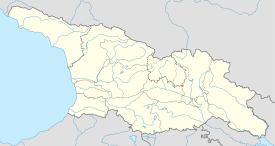Bagrati Cathedral
| Bagrati Cathedral ბაგრატის ტაძარი |
|
|---|---|

Bagrati Cathedral in 2014
|
|
| Basic information | |
| Location | Kutaisi, Imereti, Georgia |
| Geographic coordinates | 42°16′38″N 42°42′15″E / 42.2773°N 42.7043°ECoordinates: 42°16′38″N 42°42′15″E / 42.2773°N 42.7043°E |
| Affiliation | Georgian Orthodox Church |
| Country | Georgia |
| Architectural description | |
| Architectural type | Church |
| Architectural style | Georgian |
| Completed | 11th century |
| Dome(s) | 1, rebuilt |
| Official name: Bagrati Cathedral and Gelati Monastery | |
| Type | Cultural |
| Criteria | iv |
| Designated | 1994 (18th session) |
| Reference no. | 710 |
| UNESCO Region | Europe and North America |
| Endangered | 2010–present |
The Cathedral of the Dormition, or the Kutaisi Cathedral, more commonly known as Bagrati Cathedral (Georgian: ბაგრატი; ბაგრატის ტაძარი, or Bagratis tadzari), is an 11th-century cathedral in the city of Kutaisi, in the Imereti region of Georgia. A masterpiece of the medieval Georgian architecture, the cathedral suffered heavy damage throughout centuries and was reconstructed to its present state through a gradual process starting in the 1950s, with major conservation works concluding in 2012. A distinct landmark in the scenery of central Kutaisi, the cathedral rests on the Ukimerioni Hill.
Bagrati Cathedral was built in the early years of the 11th century, during the reign of King Bagrat III, due to which it was called "Bagrati", i.e., Bagrat’s cathedral. An inscription on the north wall reveals that the floor was laid in "chronicon 223", i.e., 1003. In 1692, it was devastated in an explosion by Ottoman troops who had invaded the Kingdom of Imereti. The incident caused the cupola and ceiling to collapse.
Conservation and restoration works, as well as archaeological studies at the Cathedral began in the 1950s under the leadership of a Georgian architect Vakhtang Tsintsadze. The restoration works headed by Tsintsadze were divided into six stages and continued for several decades through 1994. That same year in 1994 Bagrati Cathedral, together with the Gelati Monastery, was included in UNESCO's World Heritage Site list as a single entity. In 2001, ownership of the cathedral was transferred from the Georgian state to the Georgian Orthodox Church. It is presently of limited use for religious services, but attracts many pilgrims and tourists. It is also frequently used as a symbol of the city of Kutaisi, being one of its main tourist attractions.
...
Wikipedia

